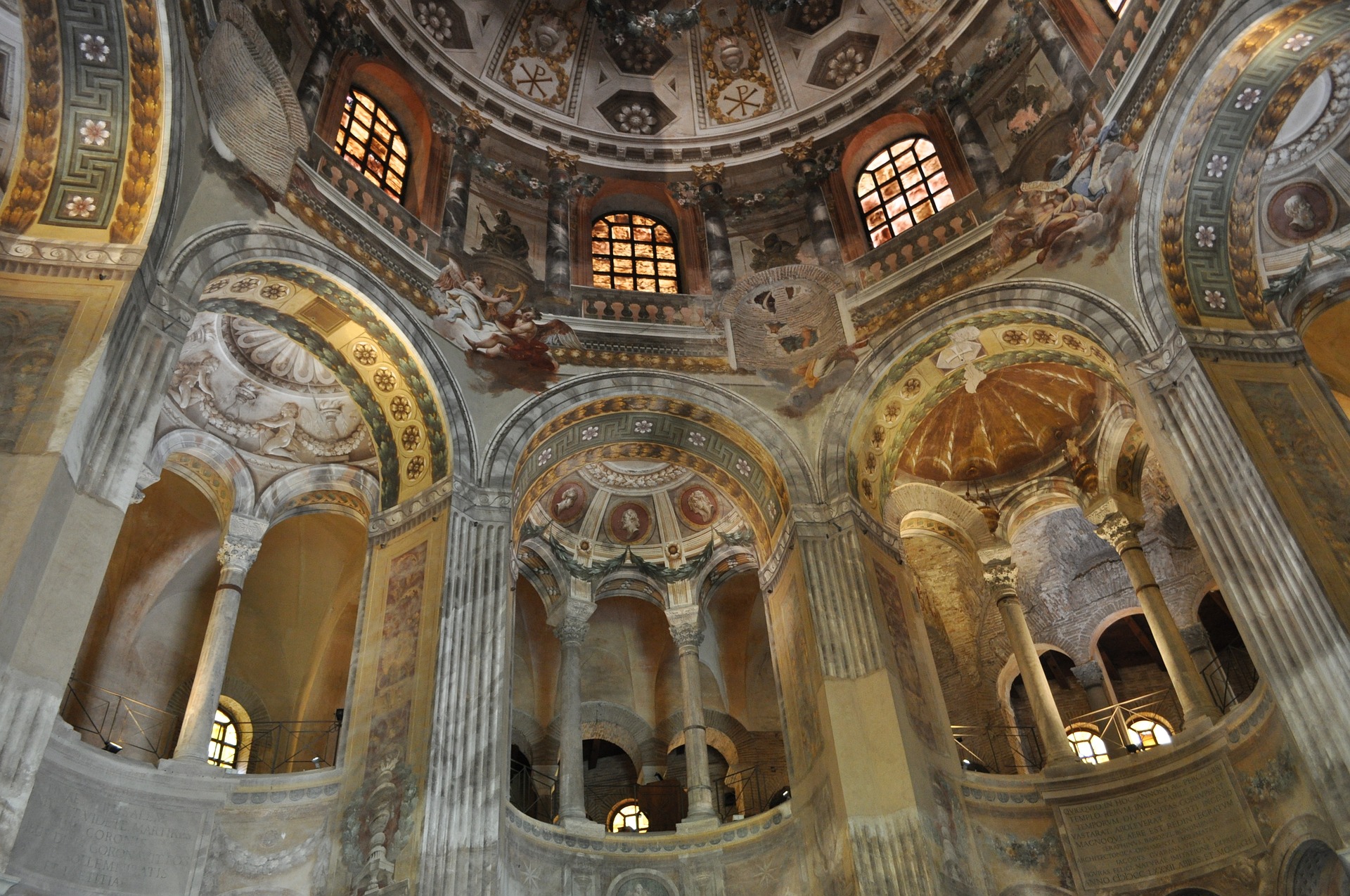One day in Ravenna: 10 attractions to visit
A historic center UNESCO World Heritage Site, a few steps from the sea and in the heart of Romagna, with its nightlife, its cultural offer and its gastronomic tradition. Ravenna is known above all for its mosaics and beaches, but its territory hides pearls of unknown value: did you know, for example, that Dante Alighieri is buried here? One day in Ravenna is not enough to visit everything, but it’s enough to explore its main attractions and discover why the city is so culturally important for Italian history and art. Here are the 10 must-see attractions when you’re on a trip to Ravenna!
 The Basilica of Sant'apollinare Nuovo
The Basilica of Sant'apollinare Nuovo
Not to be confused with Sant'Apollinare in Classe, located 8 km from the center of Ravenna, the Basilica of Sant'Apollinare Nuovo belongs to the architectural sites that have been a UNESCO World Heritage Site since 1996. Like many ancient buildings of the city, even the exterior of Sant'Apollinare seems thin and simple, to reveal a triumph of gold and opulence inside. Here is in fact one of the most important cycles of early Christian mosaics in the world: the golden tiles decorate the entire central nave and constitute a work of immense value, which traces the highlights of the life of Christ and testifies to the evolution of this art from the Theodoric period to the Byzantine age.
Piazza del Popolo
Piazza del Popolo is the beating heart of Ravenna, a place of meeting and city life and home to the most important historical buildings of the city, including that of the Municipality (also called Palazzo Merlato) and the Prefecture. Dating back to the 13th century, its construction dates back to the domination of the Da Polenta family, who transformed it into the center of public life. The two columns that rise in the square recall those of St Mark’s Square in Venice, and not by chance: the Venetian domination of Ravenna has changed over time the layout of the square, enlarging the original space and adding inserts that recall the architecture of the Serenissima.
 The Basilica of San Vitale
The Basilica of San Vitale
The Basilica of San Vitale was built in over twenty years and finished around the middle of 500, during the reign of the famous Emperor Justinian. Dedicated to the martyr Vitale, it has a rather peculiar structure with an octagonal central plan. Bare outside and rich inside, between the gold of the mosaics and the richness of the frescoes is one of the most evocative buildings in the history of Ravenna, witness to the Byzantine culture and art in the city.
The Mausoleum of Theodoric
Another Ostrogothic building is the Mausoleum of Theodoric, one of the most important funerary architecture of the late Ancient Age, belonging to the circuit of places identified as UNESCO World Heritage. It was originally located in the area designated as a necropolis, which is why it’s still located just outside the city walls. The Mausoleum documents, in its Istrian stone structure, the architectural coexistence of two cultures: the Roman one in the lower part and the barbarian one, represented by Theodoric - ruler of the Ostrogoths - in the upper part and in the decorations.
The Mausoleum of Galla Placidia
Galla Placidia was the daughter of Theodosius, a Roman empress who lived in the 5th century and commissioned this funeral structure for herself and the family. Located not far from the Basilica of San Vitale, the Mausoleum impresses with its compact location and its Latin cross structure, rather small. The building also appears to be buried about a meter and a half because of the phenomenon of subsidence, the progressive sinking of the soil that characterizes the city of Ravenna. Like many buildings in the area, the exterior appears sober and bare, and then reveal an interior of sumptuous and scenic mosaics, including the starry sky of the dome and Christ the Good Shepherd.
The tomb of Dante
Dante Alighieri died in Ravenna – the city where he was in exile – on the night of 13-14 September 1321. Despite the efforts of the Florentines to return the poet’s body to his hometown, the city welcomes the remains of Dante in a small mausoleum in the heart of the center. The tomb is a small temple built in neoclassical style that belongs to the Basilica of San Francesco, inside which was placed the sarcophagus that welcomes the poet. On the side of the building, protected by a wrought iron gate, there are silent gardens, flanked by a suggestive Franciscan cloister.
The Neonian Baptistery
Located next to the Duomo, the Neonian Baptistery is the only remaining architectural element of the ancient cathedral complex. It takes its name from Bishop Neone (but it’s also called the Baptistery of the Orthodox), and like the Basilica of San Vitale it has a central plan and an octagonal shape. Among its walls, sober on the outside like many Ravenna buildings, hides mosaics of great value, including a Baptism of Christ. You can also appreciate the garden to cross to reach it.
The Chapel of Sant'Andrea
Close to the Neonian Baptistery, a monumental staircase inside the Archbishop’s Museum leads to a chapel of rare beauty. It’s the chapel of Sant'Andrea, a place that enchants thanks to the cycle of mosaics that it preserves and that represents not only the only example of early Christian archiepiscopal chapel that has come down to us, but also the only Orthodox monument built at the time of the Ostrogothic ruler Theodoric.
The Domus of the stone carpets
Among the 10 things to see in Ravenna, you cannot miss the Domus of Tappeti di Pietra, one of the most important archaeological sites in Italy. The place was discovered in 1993 and inaugurated in 2022, is accessible through the small church of Sant'Eufemia and can be crossed through an underground path. The Domus collects in its 14 rooms the so-called "carpets" of stone, marble and polychrome mosaic floors, decorated with inlays and plant and geometric elements and datable to the Byzantine period.
The crypt Rasponi and the hanging gardens
Close to Dante’s tomb is the Crypt Rasponi, an architectural core paved in mosaics, surmounted by a neo-Gothic tower and once belonging to the homonymous palace (now destroyed). From the crypt you can access the hanging gardens, an oasis of beauty where a scenic viewpoint opens onto the area dedicated to Dante, called "the silence". A place where time is suspended and where you can fully breathe the history and culture of Ravenna.
What to eat in Ravenna
In a land of food and wine culture like Romagna, it’s not difficult to fill your stomach. Beyond the fish, a specialty that crosses the entire Adriatic coast, the area of Ravenna is famous (like the whole of Emilia Romagna) for the production of fresh pasta: one is therefore spoiled for choice between cappelletti with meat sauce, passatelli in broth, the maltagliati and the strozzapreti. The real queen of the Romagna culinary tradition is, however, the piadina, to be stuffed to taste and also appreciated in its variants, calzone and crescione.
What are you waiting for? Book our tour and let us tell you the story of this Emilia-Romagna jewel!



